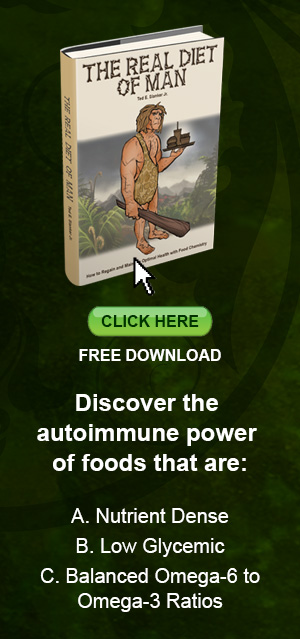It All Began in the Sea . . .
Man invented grain farming about 10,000 years ago. Life became easier and the world’s population grew rapidly. Grain became the “staff of life.” Over time, grain-farming techniques improved. In the past 200 years grain production soared due to improved plant varieties, fertilization, pesticides, mechanization, and government subsidies.
Since our country is so “advanced” and has converted its best grasslands into grain farms, it produces huge grain surpluses. As a result, grain is cheap. This has motivated food processors to use grain as a filler to cheapen the cost of their processed foods (soft and fruit drinks, ice cream, applesauce, ketchup, candies, soups, syrups, salad dressings, and condiments of all kinds—the list of “foods” is nearly endless). In addition, farmers learned they could use grain to speed up animal growth and reproduction rates. Consequently, grain is now the primary feed for all kinds of poultry, cattle, pigs, sheep, goats, fish, and even exotic animals, such as bison, deer, and elk, that are raised for food. Nearly our entire nation’s supply of egg and dairy products is from grain-fed critters.
Man’s increasing reliance on grain as food for himself, his livestock, and his pets has been motivated by grain’s low cost, abundance, stockpiling capability, transportability, and nutritional impact on everything that eats it. So, for what seemed to be for all the right reasons, man was able to make his most important need (food) almost mundane.
Nutritional Content of Food Changes
As food processors learned how to increase their proficiency in incorporating grain in their processed food products and as the percentage of livestock products from critters raised on grain in cruel confinement facilities increased, the nutrient content of our nation’s foodstuffs changed. The impact of these changes started surfacing en mass about 60 years ago when health problems (especially heart disease and cancer) started escalating. In the 1950s those diseases had become so widespread researchers started searching for the cause. They quickly discovered that animal fats were very saturated and that caused clogging of the arteries in folks whose diets were high in animal fat. Discovery followed discovery, and slowly scientists gained a better understanding of all aspects of human nutrition. While the research advanced, many theories were proposed. Some of them were way off the mark, some were close, but none of them pointed directly to what we can see so clearly today.
Unfortunately, so many corny theories were advanced and later discarded that consumers became jaded. And wouldn’t you know it, they’re still jaded. Consequently, for the most part consumers aren’t listening to the nutritional scientists who now have concrete answers to the causes of our nation’s epidemic of health problems.
In spite of the fact that health and health care costs are Americans’ number one concern, most Americans can’t see that they are paying a huge, horrible price for cheap, convenient, and plentiful food. Even though nearly all of them are suffering in one way or another from obesity, diabetes, heart disease, cancer, mental disorders of all kinds, arthritis, allergies, lupus, and a list of “body failings” that goes on and on and on, they don’t attach those problems to the only commonality all Americans share—food.
No matter where people live in America most are suffering from one or more of the aforementioned afflictions. And it’s not just adults but youngsters too. Alarmingly new disorders such as Attention Deficit Disorder, diabetes, and obesity have become commonplace in children. What could possibly be causing such uniform and widespread disease (body failings) in people living so far apart? As mentioned previously, the only environmental commonality of the 282 million ailing Americans is the food they eat. So what’s in the food?
Fatty Acids Primer
The study of fats is complex and extensive. In no way can it be fully addressed in this essay, although it can be simplified. Scientists have determined that fat consists of hundreds of various fatty acids (FAs). Some FAs are essential. Without them we would die. Many of them come only from the foods we eat—our bodies cannot make them. Two important FAs are the Omega-6 and Omega-3 fatty acids. They are two of the many compounds that make up the cell membranes in all animals in the air, on land, and in the sea. Apparently the “normal” compositional balance of these two FAs in the cell membranes of all animals lies in a ratio of about 1:1 Omega-6 to Omega-3 (“6-3”). Modern scientists have determined that when cells develop with an imbalance of these two (6-3) essential FAs, the cells tend to misfire in their function, causing bodies to fail along predisposed genetic weaknesses.
For the past one billion years, one-celled plants, diatoms, and algae have been the foundation food for all animals in the sea. Grass and the leaves of plants have been the foundation food for all animals on land. Of course, some critters do not eat grass or algae, but they eat those that do. Grasses, browse, one-celled plants, diatoms, and algae happen to be primary sources of Omega-3 fatty acids. Grain, a mature seed head of grass plants and most nuts, are primarily a source of Omega-6 fatty acids.
Before the invention of grain farming, grain played a very tiny role as a food for animals and man. Since Omega-6 fatty acids come naturally in most food sources (even grass), all critters had 6-3 FA balances that were about the same, let’s say 1:1.
But what happens to 6-3 FA balances when we have high-grain diets? Scientists have determined the results are the same for people as they are for chickens, cattle, pigs, dairy cows, and even fish. For instance, when a steer comes off pasture and goes into a feedlot, his 6-3 FA ratio is in the 1:1 to 2:1 range. After he has been in a feedlot for 200 days (some stay less, some stay more) his 6-3 FA ratio is 20:1. When people line up at the food counter and eat grains, breads, soft drinks, processed foods with grain additives, and grain-fed livestock products they are eating just like a steer at the trough in a feedlot. Scientists say the result is that many Americans have 6-3 FA ratios that are worse than feedlot steers!
Animals and People Are What They Eat
Laboratory 6-3 FA studies on rats have proven that body failures are more prevalent as the important 6-3 FA ratio moves above 4:1. And when it comes to FAs, even people are what they eat. So it’s no wonder then that a high-grain diet has the same impact on people as it does on feedlot steers. The grain makes people grow fast, mature earlier, and get fat—very fat. Also, just like livestock kept on grains for extended periods of time, people start developing a mirid of diseases (body failings) that eventually shortens their lives unless there is medical intervention in the form of operations and drugs.
There is more to FAs than just the 6-3 ratio. There are other essential FAs worthy of discussion. CLA (conjugated linoleic acid) is one of them. CLA is a major-league cancer fighter that is relatively abundant in grass-fed ruminants (cattle, goats, sheep, etc.). There is very little CLA in grain-fed ruminants. Another critical difference in fats between grass-fed and grain-fed animals is the level of saturated fat. Grass-fed livestock have low levels of saturated fat (the same levels our bodies require) whereas grain-fed livestock have very high levels.
There is no question that research on fat and its various components has progressed mightily during the past 20 years. In the process science has come full circle on what is good to eat. For all of time man relished the fat of the animals he ate. But in the 20th century he learned to fear animal fats. Now we know that if livestock and fish are raised with their natural foods during their entire lives, their fats are very good for our bodies. Also, nutritional scientists say that man’s optimum diet for a strong, healthy body should replicate the diversity that was available to him before his invention of grain farming. (That evolutionary diet is often referred to as the Paleo diet, the Hunter Gatherer diet, or the Cavemen diet.) That means vegetables, some selected fruits, wild critters (animals, bugs, and fish), no high glycemic foods, and no grain are what our bodies need to function best. The good news is, all of the “real” food products are available to all Americans who want them. Unfortunately, they are not as cheap, plentiful, or as convenient as conventional mass-produced foods. But they're a lot cheaper than when the soaring health bill Americans labor with every year is added to the price of the cheap and convenient grain-based American foods.
A great source for grass-fed livestock products of all kinds is Slanker’s Grass-Fed Meats. All of Slanker's grass-fed meats are real, legitimate foods. No other foods except green leafy plants (spinach, beat greens, romaine lettuce, etc.) are as real.
Ted Slanker
Slanker Grass-Fed Meat
https://www.texasgrassfedbeef.com




